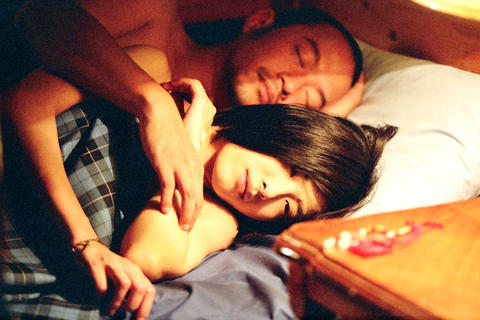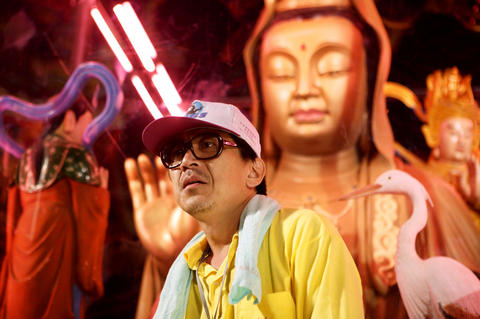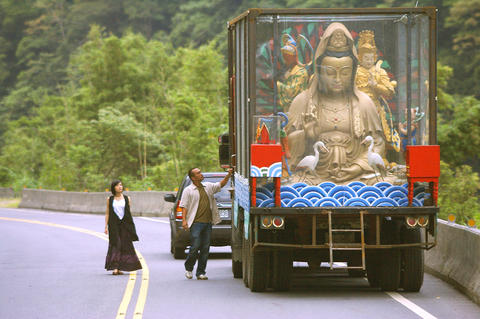Eight years after her critically acclaimed debut Bundled (我叫阿銘啦), director Singing Chen (陳芯宜) returns with her second feature, God Man Dog (流浪神狗人), an allegorical tale of contemporary Taiwan told through a mosaic of characters.
Blessed with a strong cast and production department, the film threads slices of Taiwanese life together with dreamlike visuals that linger in the mind long after the movie ends. God Man Dog has been well-received on the international film festival circuit and should also appeal to local audiences. It proves Chen, 34, is a promising, shining star among the younger generation of Taiwanese filmmakers.
The film follows the lives of characters from different ethnic groups, religious backgrounds and socioeconomic strata. It begins with Ching (Tarcy Su), a model suffering from postnatal depression who becomes increasingly estranged from her architect husband Hsiung (Chang Han) after their baby's death.

PHOTO: COURTESY OF 3RD VISION FILMS
Meanwhile, Aborigine Biung (Ulau Ugan) ekes out a living delivering fruit while attempting to cope with his alcoholism. His teenage daughter Savi (Tu Hsiao-han) escapes by becoming a kick boxer in Taipei and returns with expensive gifts after a friend enlists her in a scheme to steal money from the clients of a BDSM call-girl service.
In the third storyline, Yellow Bull (Jack Kao) drives a truck loaded with statues of deities who have been abandoned by their followers for not answering their prayers. Yellow Bull feeds stray dogs and takes in young drifter named Hsien, played by Jonathan Chang from Edward Yang's (楊德昌) Yi-Yi (一一), even though he hardly has enough money to replace his worn artificial leg. A car accident caused by a stray dog brings the three narratives together.
God Man Dog is technically accomplished and eloquently scripted. The film shows Chen as a surprisingly mature filmmaker who is able to look at the vices and virtues of Taiwanese society while telling an arresting story in a distinct style. It is an ambitious work that touches many issues, including the commodification of the body, the social problems faced by Taiwan's Aborigines, the anomie of city-dwellers, and the confused values of the young. Everything is tied together under a coherent structure by smooth editing and crosscutting between multiple characters and plot lines.

PHOTO: COURTESY OF 3RD VISION FILMS
Taiwan's collage of cultures finds a colorful epitome in Chen's vision, punctuated by the eerie sounds of a musical saw and cello by choreographer Sakamoto Hiromichi, of Hiroshima, Japan. Shen Ko-shang's (沈可尚) dynamic cinematography and atmospheric art direction by Huang Mei-ching (黃美清) help to fashion this visually imaginative film with a nod to magical realism: human-sized god puppets dancing in a deserted building, a neon-lit truck full of Buddhas wending its way through mountains under a dark sky.
On a narrative level, tragedy mixes with comedy. Storylines revolve around the film's central motif: how things are assigned value in Taiwanese society. "I reveal changing manmade values through items and things," Chen said. "Take the peach, for example. It is an expensive luxury in the eyes of Biung and his wife. In the film studio, it is merely something that can be consumed. But to Yellow Bull and Hsien, a peach is just a fruit to fill the stomach."
God Man Dog is laden with symbolism, but it is equally enjoyable for the entertainment seeker, with plenty of humorous moments of the kind that are rarely found in local productions. The most memorable of these come from the electrifying onscreen chemistry between veteran actor Kao and young Jonathan Chang. Kao shines in this film, breathing life into his Everyman role with a seemingly effortless, understated performance. Chang's equally eye-catching work suggests a star in the making. Pop idol-turned-serious actress Tarcy Su also turns in a convincing performance, although the plotline following the affluent urban couple is the film's weakest segment.

PHOTO: COURTESY OF 3RD VISION FILMS

April 14 to April 20 In March 1947, Sising Katadrepan urged the government to drop the “high mountain people” (高山族) designation for Indigenous Taiwanese and refer to them as “Taiwan people” (台灣族). He considered the term derogatory, arguing that it made them sound like animals. The Taiwan Provincial Government agreed to stop using the term, stating that Indigenous Taiwanese suffered all sorts of discrimination and oppression under the Japanese and were forced to live in the mountains as outsiders to society. Now, under the new regime, they would be seen as equals, thus they should be henceforth

Last week, the the National Immigration Agency (NIA) told the legislature that more than 10,000 naturalized Taiwanese citizens from the People’s Republic of China (PRC) risked having their citizenship revoked if they failed to provide proof that they had renounced their Chinese household registration within the next three months. Renunciation is required under the Act Governing Relations Between the People of the Taiwan Area and the Mainland Area (臺灣地區與大陸地區人民關係條例), as amended in 2004, though it was only a legal requirement after 2000. Prior to that, it had been only an administrative requirement since the Nationality Act (國籍法) was established in

With over 80 works on display, this is Louise Bourgeois’ first solo show in Taiwan. Visitors are invited to traverse her world of love and hate, vengeance and acceptance, trauma and reconciliation. Dominating the entrance, the nine-foot-tall Crouching Spider (2003) greets visitors. The creature looms behind the glass facade, symbolic protector and gatekeeper to the intimate journey ahead. Bourgeois, best known for her giant spider sculptures, is one of the most influential artist of the twentieth century. Blending vulnerability and defiance through themes of sexuality, trauma and identity, her work reshaped the landscape of contemporary art with fearless honesty. “People are influenced by

The remains of this Japanese-era trail designed to protect the camphor industry make for a scenic day-hike, a fascinating overnight hike or a challenging multi-day adventure Maolin District (茂林) in Kaohsiung is well known for beautiful roadside scenery, waterfalls, the annual butterfly migration and indigenous culture. A lesser known but worthwhile destination here lies along the very top of the valley: the Liugui Security Path (六龜警備道). This relic of the Japanese era once isolated the Maolin valley from the outside world but now serves to draw tourists in. The path originally ran for about 50km, but not all of this trail is still easily walkable. The nicest section for a simple day hike is the heavily trafficked southern section above Maolin and Wanshan (萬山) villages. Remains of